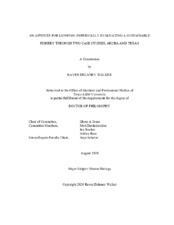| dc.description.abstract | Indo-Pacific lionfish (Pterois volitans and P. miles) are an invasive marine fish that were introduced off the coast of Florida in the 1980s and became the first established marine fish species to have invaded the Atlantic Coast, Caribbean Sea, and Gulf of Mexico. Once established, an invasive species is not likely to be eradicated, therefore, the goal becomes population suppression through organized control. Commercial harvest of lionfish has been proposed as a long-term strategy; however, until now had not been quantitatively evaluated. This dissertation created a sustainable,
lionfish fishery model that balances native reef-fish recovery, lionfish population suppression, and economic viability for commercial fishers through two case studies, Aruba and Texas. To holistically evaluate the commercialization of lionfish harvest, I gathered social data to determine the acceptance, or lack thereof, of the fish in the market; ecological data to assess population-level demographics of the fish; and economic data to aid in determining the financial viability of the fishery. In both case studies, social support for commercial harvest of lionfish was evident and the catch per
unit effort values computed from the parsimonious models matched diver removal statistics from field trials, suggesting the fishery could be viable. Additionally, current market dynamics appeared to have the capabilities to support the fishery.
Current regulatory policies would need to be adjusted, likely with an amendment to the Magnuson-Stevens Fishery Conservation and Management Act, that seeks an optimum sustainable yield (OSY) for commercial harvest of invasive marine fish. OSY prioritizes the state of the environment and economic viability of fishers, such that both work in concert to benefit ecological and social systems together. An OSY would be unique to each species, require multi-stock assessments, and integrate stakeholder engagement, social welfare, and economic interests, such that the fishery was designed
to benefit the entire human-environmental system. The long-term sustainability of global marine fish production will require a diversification of species, whereby the inclusion of under-utilized and/or invasive fish may yield a supportive alternative. This dissertation holistically addressed a serious environmental issue with an innovative solution that can be widely applicable to other marine invasive species. | en |


